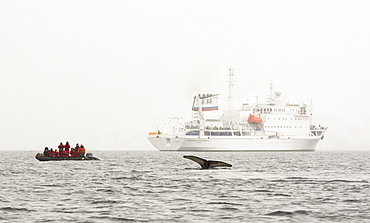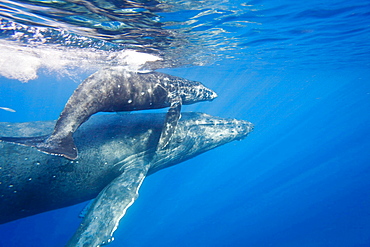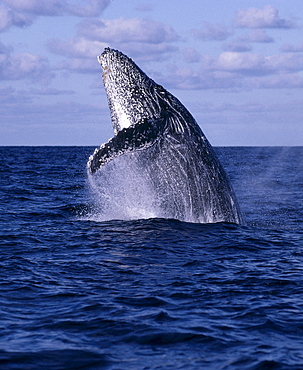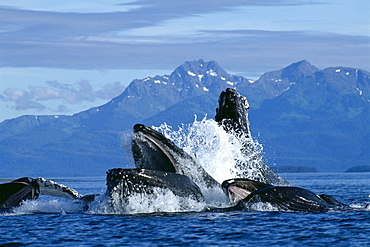Recent searches
Loading...
911-10810 - Humpback Whales (Megaptera novaeangliae) feeding on Krill in Wilhelmena Bay, Antarctic Peninsular. The whales migrate here in the summer to feed on the Krill. Krill numbers have declined by over 50%. They feed on algae that grows on the underside of sea ice, As the sea ice melts, both algae and krill decline. An expedition cruise ship in the background
911-9958 - Humpback Whales (Megaptera novaeangliae) feeding on Krill in Wilhelmena Bay, Antarctic Peninsular and surfacing wth a metre of a zodiak. The whales migrate here in the summer to feed on the Krill. Krill numbers have declined by over 50%. They feed on algae that grows on the underside of sea ice, As the sea ice melts, both algae and krill decline. This shot has penguins resting on an iceberg in the background.
1113-96978 - Breaching Humpback Whale, Megaptera novaeangliae, Indian Ocean, Wild Coast, South Africa
1113-96976 - Breaching Humpback Whale, Megaptera novaeangliae, Indian Ocean, Wild Coast, South Africa
869-4152 - humpback whale A mother and calf surface off the island of Maui Hawaii
869-4169 - humpback whale Breaching Humpback whale Megaptera novaeangliae Hawaii
869-4154 - humpback whale breaching whale in front of Lahaina Maui Hawaii
869-4155 - humpback whale whale calf leaves it's mother for a close look at the camera Hawaii
869-826 - humpback whale tail fin or fluke of diving whale above sea surface water running off fluke in front of mountains at sunset cetacean cetaceans identification profile fluke margin margins one animal only horizontal format
990-178 - Blue whale (Balaenoptera musculus) exhaling a cloud of tiny water droplets into the air. St. Lawrence estuary, Canada
990-179 - The blueish colouration pattern of Blue whales (Balaenoptera musculus) is used for photo-identification. St. Lawrence estuary, Canada
990-177 - Closeup of the expanded grooves of a giant Blue whale (Balaenoptera musculus) during a lateral lunge, a feeding strike occasionally seen in the St. Lawrence estuary, Canada.
990-173 - Tall dorsal fin of a Finback whale (Balaenoptera physalus) which is located far back along the dorsal ridge. This prominent feature is often used for identification. St. Lawrence estuary, Canada
990-171 - Tiny water droplets catch the last light of the setting sun as this Finback whale (Balaenoptera physalus) exhales blasting the air compressed in its huge lungs high into the air. St. Lawrence estuary, Canada
990-172 - Finback whale (Balaenoptera physalus) arching its back in order to dive showing its tall dorsal fin and patches of green algae that cover its back. St. Lawrence estuary, Canada
990-174 - The white tip of a Finback whaleÌs (Balaenoptera physalus) snout showing a distinctive characteristic of this species; the lower right jaw is white in colour whereas the left side is dark. Gasp», Canada
990-176 - The impressive tail stock of this Blue whale (Balaenoptera musculus) carries huge muscle bands which lead to the horizontal flukes. St. Lawrence estuary, Canada
990-175 - Finback whale (Balaenoptera physalus) might be seen alone or in pairs but often form groups of more than a dozen animals in order to hunt fish. St. Lawrence estuary, Canada (RR)
1113-92924 - Sperm Whale Eye, Physeter macrocephalus, Caribbean Sea, Dominica, Leeward Antilles, Lesser Antilles, Antilles, Carribean, West Indies, Central America, North America
1113-92921 - Social bahavior of Sperm Whale, Physeter macrocephalus, Caribbean Sea, Dominica, Leeward Antilles, Lesser Antilles, Antilles, Carribean, West Indies, Central America, North America
1113-92906 - Skin diver strokes Sperm Whale, Physeter macrocephalus, Caribbean Sea, Dominica, Leeward Antilles, Lesser Antilles, Antilles, Carribean, West Indies, Central America, North America
1113-92907 - Sperm Whale and Skin diver, Physeter macrocephalus, Caribbean Sea, Dominica, Leeward Antilles, Lesser Antilles, Antilles, Carribean, West Indies, Central America, North America
1113-92922 - Social bahavior of Sperm Whale, Physeter macrocephalus, Caribbean Sea, Dominica, Leeward Antilles, Lesser Antilles, Antilles, Carribean, West Indies, Central America, North America
1113-92914 - Social bahavior of Sperm Whale, Physeter macrocephalus, Caribbean Sea, Dominica, Leeward Antilles, Lesser Antilles, Antilles, Carribean, West Indies, Central America, North America
1113-92918 - Sperm Whale, Physeter macrocephalus, Caribbean Sea, Dominica, Leeward Antilles, Lesser Antilles, Antilles, Carribean, West Indies, Central America, North America
1113-92913 - Social bahavior of Sperm Whale, Physeter macrocephalus, Caribbean Sea, Dominica, Leeward Antilles, Lesser Antilles, Antilles, Carribean, West Indies, Central America, North America
1113-92912 - Social bahavior of Sperm Whale, Physeter macrocephalus, Caribbean Sea, Dominica, Leeward Antilles, Lesser Antilles, Antilles, Carribean, West Indies, Central America, North America
1113-92925 - Sperm Whale, Physeter macrocephalus, Caribbean Sea, Dominica, Leeward Antilles, Lesser Antilles, Antilles, Carribean, West Indies, Central America, North America
1113-92908 - Sperm Whale and Skin diver, Physeter macrocephalus, Caribbean Sea, Dominica, Leeward Antilles, Lesser Antilles, Antilles, Carribean, West Indies, Central America, North America
1113-92923 - Sperm Whale, Physeter macrocephalus, Caribbean Sea, Dominica, Leeward Antilles, Lesser Antilles, Antilles, Carribean, West Indies, Central America, North America
1113-92920 - Sperm Whale Mother and Calf, Physeter macrocephalus, Caribbean Sea, Dominica, Leeward Antilles, Lesser Antilles, Antilles, Carribean, West Indies, Central America, North America
1113-80083 - Humpback whale, mother and calf, Megaptera novaeangliae, Tahiti, French Polynesia, Rurutu, Pacific Ocean
1113-27249 - Sperm Whale, Physeter catodon, Lesser Antilles, Caribbean, Dominica
1113-27247 - Sperm Whale, Physeter catodon, Lesser Antilles, Caribbean, Dominica
1113-22853 - Sperm Whale plays with Plastic Waste, Physeter catodon, Azores, Atlantic Ocean, Portugal
1113-22852 - Young Sperm Whale, Physeter catodon, Azores, Atlantic Ocean, Portugal
1113-22854 - Sperm Whale, Physeter catodon, Azores, Atlantic Ocean, Portugal
1116-30333 - Hawaii, Maui, Humpback whale breaching with island in the background.
1116-30336 - Hawaii, Maui, Humpback whale breaching with island in the background.
1116-30318 - Hawaii, Maui, Humpback whale fluking its tail.
1116-30326 - Hawaii, Maui, Close-up of Humpback whale near the oceans surface.
1116-33291 - Hawaii, Humpback Whale (Megaptera novaeangliae) breaching.
1116-30317 - Hawaii, Maui, Humpback whale fluking its tail.
1116-29310 - Hawaii, Maui, Humpback whale breaching.
1116-38745 - Mexico, Humpback Whale (Megaptera novaeangliae) breaching, close-up C2029
1116-33296 - Hawaii, Humpback Whale (Megaptera novaeangliae) breaching.
1116-30334 - Hawaii, Maui, Humpback whale breaching with island in the background.
1116-30324 - Hawaii, Maui, Close-up of Humpback whale near the oceans surface.
1116-29862 - Hawaii, Maui, Close-up of Humpback whale near the oceans surface.
1116-30319 - Hawaii, Maui, Humpback whale fluking its tail.
1116-30323 - Hawaii, Maui, Close-up of Humpback whale near the oceans surface.
1116-38998 - Hawaii, Underside Humpback Whale (Megaptera novaeangliae) breaching, clear blue sky background D1975
1116-33295 - Hawaii, Humpback Whale (Megaptera novaeangliae) breaching.
1116-33279 - Hawaii, Humpback Whale (Megaptera novaeangliae) breaching.
1116-34350 - Hawaii, Humpback whale (megaptera novaeangliae) swimming in deep blue ocean.
1116-30328 - Hawaii, Maui, Humpback whale breaching with island in the background.
1116-33300 - Hawaii, Humpback Whale (Megaptera novaeangliae) breaching.
1116-38742 - Alaska, Humpback Whale (Megaptera novaeangliae) lunge feeding / bubble netting, herring C2028
1116-33346 - Hawaii, Humpback Whale (Megaptera novaeangliae) breaching.
1116-38993 - Alaska, Humpback Whale (Megaptera novaeangliae) breaching Inside Passage with snowcapped mountains background distance D1970
1116-33297 - Hawaii, Humpback Whale (Megaptera novaeangliae) breaching.
1116-30335 - Hawaii, Maui, Humpback whale breaching with island in the background.
1116-33302 - Hawaii, Humpback Whale (Megaptera novaeangliae) breaching.
1116-30329 - Hawaii, Maui, Humpback whale breaching.
1116-33292 - Hawaii, Humpback Whale (Megaptera novaeangliae) breaching.
1116-33294 - Hawaii, Humpback Whale (Megaptera novaeangliae) breaching.
1116-33301 - Hawaii, Humpback Whale (Megaptera novaeangliae) breaching.
1116-38740 - Mexico, Humpback Whale (Megaptera novaeangliae) breaching, close-up C2025
1116-30337 - Hawaii, Maui, Humpback whale breaching.
1116-30325 - Hawaii, Maui, Close-up of Humpback whale near the oceans surface.
1116-30327 - Hawaii, Maui, Close-up of Humpback whale near the oceans surface.
1116-33278 - Hawaii, Humpback Whale (Megaptera novaeangliae) showing baleen.
1116-33276 - Hawaii, Humpback Whale (Megaptera novaeangliae) breaching.
1116-29863 - Hawaii, Maui, Humpback whale breaching with island in the background.
1116-33290 - Hawaii, Humpback Whale (Megaptera novaeangliae) breaching.
1116-30316 - Hawaii, Maui, Humpback whale fluking its tail.
1116-38995 - Hawaii, Close-up side view of Humpback Whale (Megaptera novaeangliae) breaching, Pacific Ocean D1951
1116-30320 - Hawaii, Maui, Humpback whale fluking its tail.
1116-30332 - Hawaii, Maui, Kaanapali, Humpback whale breaching with island in the background.
1116-33275 - Mexico, San Ignacio Lagoon, dead Gray Whale (Eschrichtius robustus) on beach surrounded by seagulls.
1116-30322 - Hawaii, Maui, Humpback whale fluking its tail.
1116-33280 - Hawaii, Humpback Whale (Megaptera novaeangliae) breaching.
1116-39012 - [DC] Alaska, Baranof Island Humpback Whale (Megaptera novaeangliae) breaching Inside Passage Chatham Strait D1939
1116-38997 - Hawaii, Side view Humpback Whale (Megaptera novaeangliae) breaching, Pacific Ocean D1962
1116-33289 - Hawaii, Humpback Whale (Megaptera novaeangliae) breaching.
1116-30321 - Hawaii, Maui, Humpback whale fluking its tail in golden sunset.
832-28254 - Humpack Whales bubble net feeding (Megaptera novaeangliae), Baleen Whales, Inside Passage, Alaska, USA
832-28241 - Humpback Whale breaching (Megaptera novaeangliae), Baleen Whales, Alaska's Inside Passage, Alaska, USA
1198-80 - Grey whale (eschrichtius robustus) san ignacio, baja california, mexico, close-up of barnacles and lice on whales skin
1198-499 - Grey whale (eschrishtius robustus) showing flipper above water, heavy scarring, san ignacio, mexico
971-10 - Baleen whale skull showing baleen plates, Nouamghar, Mauritania (RR)
1060-14 - New born baby humpback whale calf, white in colour, curious and playful. Vava'u Tonga South Pacific
1060-15 - Humpback male and female adults courting above the shallow reef, Vava'u Tonga, South Pacific
1060-16 - Humpback whale calf ascends to the surface for a closer view, Vava'u Tonga, South Pacific
1060-12 - Humpback female and her calf Vava'u Tonga in the South Pacific, shot with a fisheye lens
1060-8 - This new born calf with its mother graceful glide together as the mother protects her calf and the calf learns essential behaviour to survive the open ocean. taken in Vava'u Tonga South Pacific
947-7 - Humpback whale (Megaptera novaeangliae) bubble net feeding, taken from the air. Gulf of Maine, USA (RR)
1060-11 - Two adult Humpback whales courting, Vava'u Tonga in the South Pacific
1072-6 - mother and calf Humpback whales. Revillagigedo Islands, Pacific Ocean
1074-29 - A rare, aerial view of a Blue whale (Balaenoptera musculus) surfacing near whale-watching boat in the fjords, near Husavik, on the north coast of Iceland.


















































































![[DC] Alaska, Baranof Island Humpback Whale (Megaptera novaeangliae) breaching Inside Passage Chatham Strait D1939<br />1116-39012 [DC] Alaska, Baranof Island Humpback Whale (Megaptera novaeangliae) breaching Inside Passage Chatham Strait D1939](https://images.robertharding.com/zoom/RM/RH/VERTICAL/1116-39012.jpg)
















